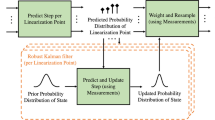Abstract
An open problem in Simultaneous Localization and Map** (SLAM) is the development of algorithms which scale with the size of the environment. A few promising methods exploit the key insight that representing the posterior in the canonical form parameterized by a sparse information matrix provides significant advantages regarding computational efficiency and storage requirements. Because the information matrix is naturally dense in the case of feature-based SLAM, additional steps are necessary to achieve sparsity. The delicate issue then becomes one of performing this sparsification in a manner which is consistent with the original distribution.
Access this chapter
Tax calculation will be finalised at checkout
Purchases are for personal use only
Preview
Unable to display preview. Download preview PDF.
Similar content being viewed by others
References
Y. Bar-Shalom, X. Rong Li, and T. Kirubarajan. Estimation with Applications to Tracking and Navigation. John Wiley & Sons, Inc., New York, 2001.
T. Duckett, S. Marshland, and J. Shapiro. Learning globally consistent maps by relaxation. In Proceeding of the IEEE International Conference on Robotics and Automation (ICRA), pages 3841–3846, San Francisco, USA, 2000.
R. Eustice, H. Singh, and J. Leonard. Exactly sparse delayed state filters. In Proceedings of the IEEE International Conference on Robotics and Automation (ICRA), pages 2428–2435, Barcelona, Spain, April 2005.
R. Eustice, H. Singh, J. Leonard, M. Walter, and R. Ballard. Visually navigating the RMS Titanic with SLAM information filters. In Proceedings of Robotics: Science and Systems (RSS), Cambridge, MA, USA, June 2005.
R. Eustice, M. Walter, and J. Leonard. Sparse extended information filters: Insights into sparsification. In Proceedings of the IEEE/RSJ International Conference on Intelligent Robots and Systems (IROS), Edmonton, Alberta, Canada, August 2005.
U. Frese. A proof for the approximate sparsity of SLAM information matrices. In Proceedings of the IEEE International Conference on Robotics and Automation (ICRA), pages 331–337, Barcelona, Spain, April 2005.
U. Frese. Treemap: An O(log n) algorithm for simultaneous localization and map**. In C. Freksa, editor, Spatial Cognition IV, pages 455–476. Springer Verlag, 2005.
U. Frese and G. Hirzinger. Simultaneous localization and map**-a discussion. In Proceedings of the IJCAI Workshop on Reasoning with Uncertainty in Robotics, pages 17–26, 2001.
U. Frese, P. Larsson, and T. Duckett. A multilevel relaxation algorithm for simultaneous localization and map**. IEEE Transactions on Robotics, 21(2):196–207, April 2005.
Y. Liu and S. Thrun. Results for outdoor-SLAM using sparse extended information filters. In Proceedings of the IEEE International Conference on Robotics and Automation (ICRA), pages 1227–1233, Taipei, Taiwan, 2003.
Peter S. Maybeck. Stochastic Models, Estimation, and Control, Volume 1. Academic Press, New York, NY, 1979.
M. Paskin. Thin junction tree filters for simultaneous localization and map**. Technical Report CSD-02-1198, University of California, Berkeley, September 2002.
Jonathan Shewchuck. An introduction to the conjugate gradient method without the agonizing pain. Technical Report CMU-CS-94-125, Carnegie Mellon University, August 1994.
R. Smith, M. Self, and P. Cheeseman. Estimating uncertain spatial relationships in robotics. In I. Cox and G. Wilfong, editors, Autonomous Robot Vehicles, pages 167–193. Springer Verlag, 1990.
S. Thrun, Y. Liu, D. Koller, A.Y. Ng, Z. Ghahramani, and H. Durrant-Whyte. Simultaneous localization and map** with sparse extended information filters. International Journal of Robotics Research, 23(7–8):693–716, July–August 2004.
Author information
Authors and Affiliations
Editor information
Editors and Affiliations
Rights and permissions
Copyright information
© 2007 Springer-Verlag Berlin Heidelberg
About this paper
Cite this paper
Walter, M., Eustice, R., Leonard, J. (2007). A Provably Consistent Method for Imposing Sparsity in Feature-Based SLAM Information Filters. In: Thrun, S., Brooks, R., Durrant-Whyte, H. (eds) Robotics Research. Springer Tracts in Advanced Robotics, vol 28. Springer, Berlin, Heidelberg. https://doi.org/10.1007/978-3-540-48113-3_20
Download citation
DOI: https://doi.org/10.1007/978-3-540-48113-3_20
Publisher Name: Springer, Berlin, Heidelberg
Print ISBN: 978-3-540-48110-2
Online ISBN: 978-3-540-48113-3
eBook Packages: EngineeringEngineering (R0)




